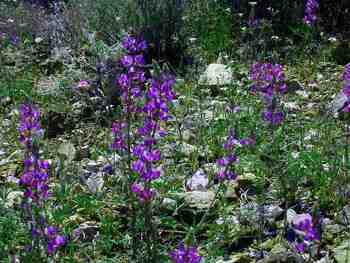
Delphinium

The annual larkspurs and the perennial delphiniums comprise a genus of over 250 species of herbs from two to six feet tall. The prevailing colour of the flower is blue, while cultivated forms have other colours, as well as double blooms. Ingesting young leaves before the flowers appear is a frequent cause of poisoning. Toxicity decreases as the plants age. Later in the season poisoning comes from eating the small seeds which hold the toxic alkaloids in concentrated amounts. These plants, if eaten in quantity cause upset stomach, abdominal cramps, bloating, twitching muscles, nervous symptoms, paralysis, and death.
Tall larkspur, (Delphinium glaucuma) a member of the buttercup family, is a tall stately perennial with stems two to six feet tall. It is common in the foothills of the Rocky Mountains and the central interior of B.C. If an animal eats as little as 0.7 percent of its weight of young plants, it will die.
Low larkspur (Delphinium bicolor) is also a member of the buttercup family and has stems up to 18 inches high. All parts of the plant are poisonous. It is readily grazed by both cattle and sheep, but sheep are seldom poisoned by it.
The USDA Poisonous Plant Research Laboratory site has more information on delphinium.
Previous Plant Page • Back to Poison Plant Index • Next Plant Page

Brian and Jane Pinkerton
29343 Galahad Crescent
Mount Lehman
British Columbia
Canada V4X 2E4
Phone: 604-856-3196
e-mail address:
Mount Lehman Llamas Farm Page • Llama Question and Answer Page • Llama Trivia